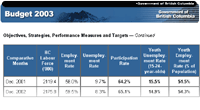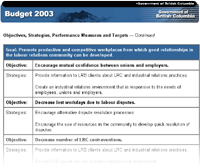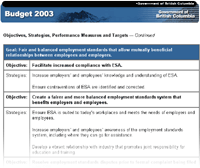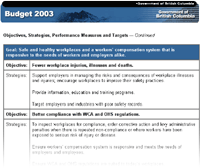 |
|
|
 |
 |
2003/04 – 2005/06 SERVICE
PLAN
Ministry of Skills Development and Labour |
 |
 |
Objectives, Strategies, Performance Measures and Targets
Labour market indicators are influenced by a variety of factors.
This creates difficulty in determining attribution when the indicators
change, positively or negatively. Thus, the Ministry of Skills Development
and Labour is limited in the indicators for which it can claim accountability.
The following broad labour indicators provide an illustration of
the employment situation in B.C. and provide the framework within
which the ministry works. All data is seasonally adjusted.
The following pages provide an overview of key ministry goals for
each core business area, the strategies that will be used to meet
these goals and the measures that will be used to determine progress.
In addition to ministry policy and legislative initiatives, the
overall state of the provincial economy, as well as national and
global economic events, will significantly influence these measures.
The Labour Relations Board has undergone significant operational
changes in 2002/03. Together with changes to the Labour Relations
Code, this has meant that baseline data for 2003/04 have been
substantially revised from the previous year's service plan. In
doing so, the ministry has sought to identify anticipated improvements
rather than specific targets. If the Labour Relations Code
is further amended in the future, this may have impacts on the measures
as well.
Likewise, changes to the Employment Standards Act, as well
as the restructuring of the Employment Standards Branch, have meant
that the 2003/04 baseline data for this core business have been
substantially revised from the previous year's service plan. The
introduction of self-help materials, the shift from an investigative
to a mediation and adjudication model, and compliance partnerships
with industries are expected to substantially affect ministry measures.
Similarly, the ministry has sought to identify anticipated improvements
rather than specific targets. A case in point is the number of complaints
received by the ESB. A decline in the number of complaints could
be attributable to a number of factors, such as the improved effectiveness
and efficiency of the self-help kits. Likewise, an increase in the
number of complaints in the future may be attributable to a substantial
upswing in the provincial economy. As the number of British Columbians
finding work increases, the overall number of complaints may also
increase even though on a per capita basis the number of complaints
remains stable. Further more detailed output measurements will be
developed in future years as the changes to employment standards
become operational and established.
As an independent Crown agency, the WCB identifies and measures
performance against its own major objectives. This includes measures
for the recently established Review Division, which will be the
first level of appeal for workers' compensation matters in a revamped
appeal system.
As a result of changes to the Workers Compensation Act,
the new independent Workers' Compensation Appeal Tribunal (WCAT)
is expected to be in full operation by March 2003. WCAT will be
the second and final appeal level in the new system, which was introduced
to address delays, complexity and lack of consistency in the present
system. The ministry has identified anticipated improvements for
the appeal system to ensure fair, timely and consistent decisions.
Several legislative changes are designed to assist WCAT with these
objectives, such as maximum time frames for decisions, a new role
for medical advisors, and policy that will be binding on the workers'
compensation system as a whole. It is premature to provide measures
and targets at this point, given that WCAT is not yet operative.
However, WCAT will be measuring its progress in 2003 to assist in
establishing appropriate measures and targets for subsequent years.
|
|





